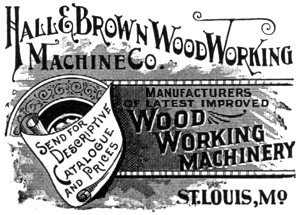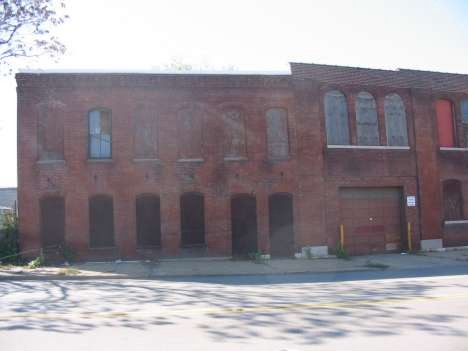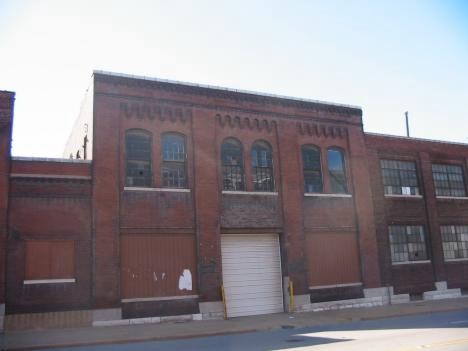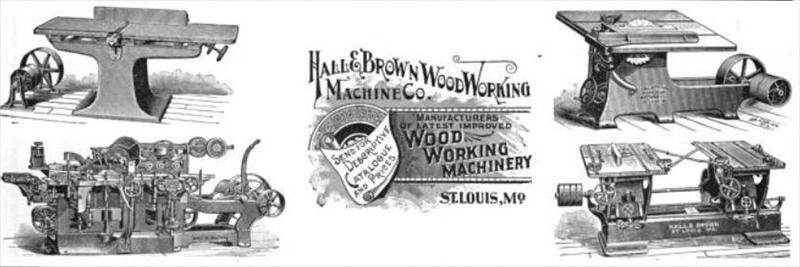
The Early Years: 1877 to 1888
According to the "Encyclopedia of the History of St. Louis", Hall & Brown Wood Working Machine Co. was founded in 1877 by Gorham O. Hall and Charles Swing Brown. Hall, born in New Hampshire, went to work for H. B. Smith in Lowell, MA, and then relocated to Smithville, NJ, in 1865 as foreman of Smith's plant; he later became superintendent of the Works. He resigned in 1877 to go west with Brown to start their own business, Hall & Brown.
Charles S. Brown had been born in Browns Mills, NJ, on 27 November 1852, and did his apprenticeship with H. B. Smith starting in 1870. After serving as a journeyman for three years he became the foreman of the pattern works.
When the two men went to St. Louis in 1877 they operated for a time at 717 So. Seventh Street, and later moved to 1913 North Broadway. (An 1882 ad says the address was 1857-1863 Broadway. The address may have been renumbered, rather than the factory moved.) In their new location they incorporated in 1888 (or 1886, according to one source) and established Hall as president, Brown as vice president.

1913 N. Broadway, Hall & Brown Main Office
The Expansion Years: 1888 to 1910
During this time, the factory gradually expanded in size, moving from 1913-1921 N Broadway in 1891 to 1929 by about 1905. A more architecturally interesting expansion occurred in 1910 with construction of the building at 1931, designed by St Louis architect Gerhard Becker. This is an attractive two-story Romanesque Revival style building which housed the millwork and machine rooms. It is much more interesting than the next building, 1933, which was apparently in place by 1912. (A 1909 map shows a single building occupying both these addresses. That building was apparently demolished to make way for these.) This was the height of Hall & Brown's expansion.

Millwork and Machinery Building, 1931 N Broadway, built in 1912.
Gorham Hall died in 1897, at which time Brown, as principal stockholder, took over as president of the company.
1897 was a watershed in the woodworking machinery industry, with eleven companies merging to create the colossal American Wood Working Machinery Co. Hall & Brown was rumored to be considered as part of this merger, but ultimately they remained separate. Perhaps they, being in St. Louis, were too far away from the other eleven companies, which were mainly in New York and Pennsylvania.
In 1899, the first industry association was formed in response to a series of patent debacles (e.g., see the Manufacturers Index entries for Woodbury Patent Planing-Machine Co. and the Boston Conductory Co.); Charles S. Brown was a key participant.
In the 1890-1910 period Hall & Brown's product line was extremely large. An extant 1892 catalog (#6) is over 500 pages long, while the #10 catalog (circa 1905) has 398 smaller print pages. These included a full line of machines (jointers, tablesaws, bandsaws, moulding machines, tenoners, mortisers, etc.) plus many pages of replacement parts. At least 13 of the major machines pictured in the 1912 catalog are marked as "new", so they were extensively upgrading their product line in this era. The "Universal Wood-Worker" was an interesting example. Mostly a jointer, it had a boring/routing attachment on the back side of the jointer head, while the tables could be moved far enough apart to accommodate a sawblade of up to 12 inches. This sawblade extended through a wooden insert set between the tables. It could also use moulding heads and apparently could do tenons also. Many machines in this catalog have optional electric motors, and some of the bandsaws have full wheel guards. These wheel guards are one-sided, with a solid lower and a heavy gauge wire upper. Hall & Brown was also a machinery dealer. Their catalogs show a very large assortment of accessories and parts, so many that it's unlikely they manufactured most of them.

Ad from January 1901 "The Wood Worker"
The Mature Years: 1910-1930
Hall & Brown produced a large variety of machinery through the 1920s, and kept developing new models. A circa-1929 catalog shows a "new" model 197 jointer, available in 8", 12", and 16" sizes. This was a 3-legged machine, considerably different than the #1 and #2 pedestal-based jointers appearing through the 1912 catalog. Curiously, square heads were still available on this type of jointer (as shown by Charles McGough's 8" #197, which originally had one.) An extant model 234 single-spindle borer probably dates from this period also, since it doesn't show in catalogs up to 1920.
In 1925, Charles S. Brown, at age 73, was still president of the company. One of three vice presidents was John Yerkes, one of the founders of Yerkes & Finan. The Yerkes & Finan company was closely associated with Hall & Brown for most of Y&F's existence. Like Gorham Hall and Charles Brown, John Yerkes was an H. B. Smith alumnus who relocated to St. Louis. Peter A. Finan married Gorham Hall's daughter. There are machines labeled with both the Hall & Brown and Yerkes & Finan names, including a single-end tenoner and a vertical slot mortiser. A 16" Yerkes & Finan jointer sold on eBay was a dead ringer for a Hall & Brown #2.
The Declining Years: 1930-1960
Information on Hall & Brown after 1930 is spotty. Charles Brown died in 1932. The company was hit hard by the Depression. By 1941, they had relinquished most of the buildings in their factory, keeping little other than the building at 1933 N Broadway. They may have stopped most manufacturing by this time, becoming a machinery dealer. There is a Heston & Anderson bandsaw that has been rebadged with a Hall & Brown logo that may date from this era, since Heston & Anderson didn't begin large scale manufacturing before 1925. St Louis phone books continue to show a listing through 1960, finally disappearing from the 1961 book.
Hall & Brown Machinery
In general, Hall & Brown machines were plain, robust industrial machinery. They show a minimum amount of ornamentation, even in the Victorian era. Up to the 1920s, many share a flared pedestal base with the Hall & Brown name prominently cast on the front. With their huge catalogs, they were plainly trying to be a one-stop supplier to furniture manufacturers and others in wood-using industries, rather than trying to dominate the market for a few types of machines such as bandsaws or planers.
Hall & Brown Catalogs
For help in dating Hall & Brown catalogs, check out this posting in the OWWM discussion forum.
Information Sources
Special thanks to Kirk Poore, who did much of the research and writing for this Manufacturers Index entry.
- Hall & Brown Catalog #6 (ca. 1892), owned by the Missouri Historical Society (MHS)
- Hall & Brown Catalog #10 (ca. 1900-1905) (MHS)
- Hall & Brown Sectional Catalog, 1912 (MHS)
- Hall & Brown Catalog, ca. 1920 (Dave Potts)
- Hall & Brown Catalog, ca. 1929 (Jeff McVey)
- Sanborn Fire Insurance Company maps (1909, 1941) (St Louis Public Library)
- Who's Who in North St Louis, 1925 (MHS)
- Encyclopedia of the History of St Louis, vol 2 (MHS)
- St Louis: Her Trade, Commerce, and Industries 1882-3, John E. Land (MHS)
- St Louis Furniture News, Oct 1891 & April 1912 (MHS)
- The Missouri Historical Society was particularly helpful in retrieving Hall & Brown related materials.
- Carriage and Wagon Makers Machinery and Tools by Kenneth L. Cope, 2004 page 105